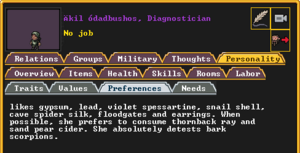- v50 information can now be added to pages in the main namespace. v0.47 information can still be found in the DF2014 namespace. See here for more details on the new versioning policy.
- Use this page to report any issues related to the migration.
Thoughts and preferences
v53.06 · v0.47.05 This article is about the current version of DF.Note that some content may still need to be updated. |
Very informational screens about someone or something's profile is the thoughts and preferences screen, accessible by clicking on a dwarf, or most other residents in or near your fortress, and clicking on the "thoughts" or "personality" tab. Unlike previous versions of the game, this version does not combine the two. Instead, this information is separated by multiple tabs. The thoughts tab will have the "recent thoughts" and "memories" sub-tabs. The personality tab will have the "traits", "values", "preferences" and "needs" sub-tabs. These will give you a detailed breakdown of your dwarves' happiness and thoughts, memories, preferences, mental attributes, and personality traits.
All dwarves have two pieces of their profiles in common: "He/she needs alcohol to get through the working day" (indicating that all dwarves are alcoholics), amongst their personality traits, and "A short sturdy creature fond of work and industry" at the end of the screen (this is actually the dwarf's tagline, and will appear at the beginning for all other creatures).
Thoughts
This first section is in grey, with extremely recent thoughts in white. It may be preceded by either a white quote from the dwarf or a colored note about their emotional status (eg. dark red for Enraged) or stress level. Stress level is invisible to the player until stress starts to bother the dwarf, at which point they start flashing the downward red arrow of unhappiness and may cancel jobs in order to space out. These temporary breaks from reality can turn into permanent insanity if the sources of the dwarf's unhappiness are not removed.
Emotional reactions are loosely color-coded, with positive thoughts being in blue or green and strong negative thoughts being in red or yellow. Brown thoughts are mildly to moderately negative, and purple and grey ones are pretty much neutral. Positive thoughts lower stress levels, and negative thoughts raise it. Pink thoughts represent memories, which trigger stress changes based on what is being recalled and may change personality traits and values over time.
Preferences
Dwarves like certain materials, colors, animals, and brews of alcohol, and detest certain vermin. Being exposed to these likes or dislikes will give them a higher-than-normal chance of getting a higher-than-normal positive or negative thought, respectively. This comes in handy most when designating dwarves for duties, as dwarves love to work with materials and creatures of their preferences, and will produce higher quality goods as a result. Being able to outfit nobles' quarters with classy preferable items is a perk, too. This section is in green again.
Mental attributes
Mental attributes work in much the same way as physical attributes, are listed in the same way, and come in a much greater variety. Most affect how your dwarves are able to do their jobs, as certain mental abilities are important in certain trades.
Values
The belief section is composed of two parts, the cultural and personal beliefs.
Cultural beliefs
Cultural beliefs are the beliefs that the creature holds that are considered "on par" with their culture.
Typically, cultural beliefs will look something like this:
- "Like others in his culture, he holds craftsdwarfship to be of the highest ideals and celebrates talented artisans and their masterwork, has a great deal of respect for the law, values family greatly, sees friendship as one of the finer things in life, believes that honesty is a high ideal, greatly respects artists and their work, really respects those that take the time to master a skill, deeply respect those who work hard at their labors, respects fair-dealing and fair-play, values cooperation, finds merrymaking and partying worthwhile activities, values martial prowess, values leisure time, respects commerce and finds nature somewhat disturbing." Certain beliefs can conflict with personality traits.
Personal beliefs
Below the cultural beliefs are the individual beliefs, beliefs the creature holds that go against their "typical" culture.
Dreams
Some creatures dream of accomplishing certain goals in their life, and these dreams can presumably affect their behavior. If a creature has such dreams, they will be listed in the Values sub-tab of the Personality tab. If said dream has actually been fulfilled, the description will include "and this dream was realized". They will also get a strong happy thought upon completing it.[Verify]
Traits
A dwarf's personality traits affect a lot of things - a nervous wreck of a wood cutter would be very quick to become unhappy if they are unlucky enough to be ambushed by a foe while felling a tree, even if they come out on top in the ensuing encounter. Some are truly meaningless ("she always takes a deep breath whenever she is surprised"), but many affect how the dwarf works and relates to others. Personality traits affect how and what social skills a dwarf trains.
While not a true personality trait, if the dwarf has become desensitized to tragedy, that will be mentioned at the end of this section of their profile, through the lines, "He/She is getting used to tragedy," "He/She is a hardened individual," or for full desensitization, "He/She doesn't really care about anything anymore."
Needs
Needs are similar to thoughts, except they affect focus (which has to do with productivity and combat effectiveness) rather than with the risk of tantrums. Dwarves become unfocused if their needs are not met, and individual dwarves have different needs depending on their particular beliefs. Needs that are unmet for long enough become bad thoughts.
